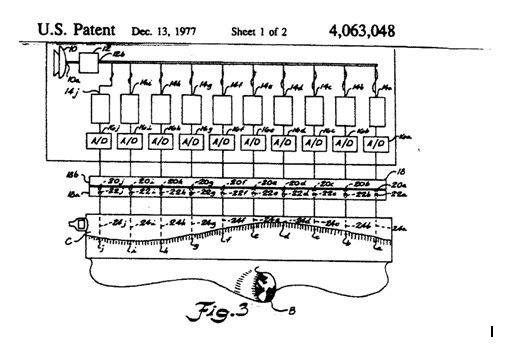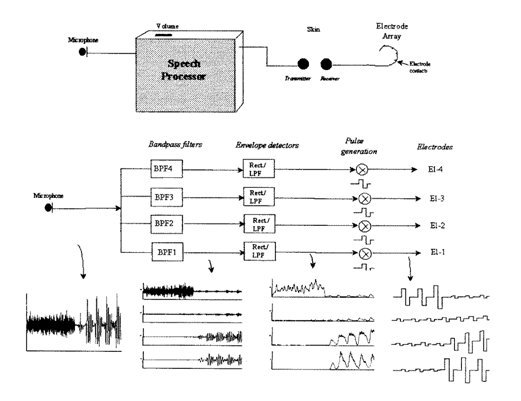Introduction
Helen Keller wrote in her autobiography, The Story of My Life (first published in 1905): “I am just as deaf as I am blind. The problems of deafness are deeper and more complex, if not more important, than those of blindness. Deafness is a much worse misfortune. It means the loss of the most vital stimulus. The sound of the voice that brings language sets thoughts astir and keeps us in the intellectual company of a man.”
What is a cochlear implant?
A cochlear implant consists of:
- A microphone that picks up sound from the environment.
- A speech processor that synthesizes incoming audio signals into a parallel array of sinusoidal bands, spectral densities, or frequency bands of tones. The bands are converted into a subsequent (parallel) array of digital stimuli. These stimuli are applied simultaneously through several conductors that terminate in a circular pattern.
- A “transmitter” connector is held behind the ear by magnetism.
The stimuli are then sent by electromagnetic induction (transformer coupling) through the skin to a secondary (4) similar pattern as the above receptor array of wire conductors. The wire conductors are implanted under the skin of the patient. Still, in a parallel array, these stimuli are routed through the wire conductors to specific locations within the cochlea. These represent specific tonal receptors of the eighth cranial nerve, leading to the brain’s hearing sector. The cochlear implant (CI) is a surgically implanted electronic device. The device provides a sense of sound to persons who are profoundly deaf or severely hard of hearing.
An implant does not “heal” a non-functioning cochlea or restore normal hearing. Rather, it can give a deaf person enough useful reproduction of sounds to greatly enhance their ability to interpret sounds in the environment and understand speech.
How Do They Differ from Hearing Aids?
Hearing aids amplify sounds. They require some portion of the normal hearing mechanism to be functional. Cochlear implants bypass damaged portions of the ear and directly stimulate the auditory (eighth cranial) nerve. The implant directly routes sound stimuli to the brain’s hearing center, recognizing the signals as meaningful sounds. Hearing through a cochlear implant differs from normal hearing. It often requires time to learn the meaning of sounds. Especially, if the patient was pre-lingually deaf or to relearn prior sound interpretations if patients became deaf after learning to speak.
Experimentation
In recent years extensive and competitive experimentation has been performed. Experiments by many manufacturers to exploit all possible methods of synthesizing and applying the detected electrical audio stimuli to the acoustic nerve, in a continual effort to achieve the maximum possible intelligence, fidelity, and clarity of audio information. The preponderance of current implants is the outgrowth of the multi-channel design described in US Patent 4063048 (10).
Also, many experiments by the House Ear Institute in single conductor implants have succeeded in specialized applications. Many new strategies have been researched for increasing the effective number of audio channels applied to the acoustic nerve. Thereby helping to provide greater fidelity in a true reproduction of original audio inputs.
Cost of a Cochlear Implant
The American Speech & Hearing Association (AHSA) has considered the cost of a cochlear implant, which varies quite widely from patient to patient. The cost varies even concerning the location or institution from which an implant is received since implants are available in many countries worldwide. It also varies with the patient’s age, whether child, infant, or adult. Also, it varies concerning the many causes and reasons for the patient’s deafness, including how long the patient has been deaf.
According to the American Speech and Hearing Association, the average cost of an implant, including the entire surgical procedure, medical staff, hospital, and operative medical and aural rehab, is $40,000 to $60,000. Even at these seemingly exorbitant costs, researchers at Johns-Hopkins Hospital show that “more than $50,000 can be saved compared to the cost of more than $1,000,000 in expenses expected over a lifetime to cover the cost of children who are profoundly deaf”.
Design
All cochlear implants employ the same basic design (with many ancillary variations) and have a similar range of performances. Other criteria are considered when choosing a cochlear implant and comparing costs, such as:
- the usability of external components, cosmetic factors, battery life
- whether replaceable or rechargeable
- the versatility of internal and external components, customer service from the manufacturer
- experience of the implanting physician
- qualifications of the audiologists concerning mapping (software-guided set-up for each patient)
- quality of familiarity of personnel with a particular device.
The figure below represents the basic design of the cochlear ear implant patented by Adam Kissiah in 1977.
Figure 1
Patent 4063048 Cochlear Implant, Adam Kissiah, Jr.
The figure below illustrates the current design of the cochlear ear implant. The basic design is virtually identical to the design from the original patent.
Figure 2
For comparison with modern designs, refer to the design of Dr. Phillip C. Loizou, Professor in the Engineering Department of The University of Texas at Dallas.


